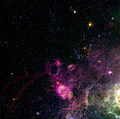- Tarantula Nebula
-
Tarantula Nebula 
The Tarantula Nebula, first light image of the TRAPPIST national telescope at La Silla ObservatoryObservation data: J2000 epoch Type Emission Right ascension 05h 38m 38s[1] Declination -69° 05.7′[1] Distance 160 ± 10 kly (49 ± 3 kpc)[2][3] Apparent magnitude (V) +8[2] Apparent dimensions (V) 40′ × 25′[2] Constellation Dorado Physical characteristics Radius 500 ly Absolute magnitude (V) ~ -11.7 Notable features In LMC Other designations NGC 2070,[2] Doradus Nebula,[1] Dor Nebula,[1] 30 Doradus See also: Diffuse nebula, Lists of nebulae The Tarantula Nebula (also known as 30 Doradus, or NGC 2070) is an H II region in the Large Magellanic Cloud (LMC). It was originally thought to be a star, but in 1751 Nicolas Louis de Lacaille recognized its nebular nature.
The Tarantula Nebula has an apparent magnitude of 8. Considering its distance of about 49 kpc[2] (160,000 light years), this is an extremely luminous non-stellar object. Its luminosity is so great that if it were as close to Earth as the Orion Nebula, the Tarantula Nebula would cast shadows[4]. In fact, it is the most active starburst region known in the Local Group of galaxies. It is also the largest such region in the Local Group with an estimated diameter of 200 pc.[3] The nebula resides on the leading edge of the LMC, where ram pressure stripping, and the compression of the interstellar medium likely resulting from this, is at a maximum. At its core lies the compact star cluster R136 (approx diameter 35 light years)[5] that produces most of the energy that makes the nebula visible. The estimated mass of the cluster is 450,000 solar masses, suggesting it will likely become a globular cluster in the future.[6]
In addition to R136, the Tarantula Nebula also contains an older star cluster—catalogued as Hodge 301—with an age of 20–25 million years. The most massive stars of this cluster have already exploded in supernovae.[7]
The closest supernova observed since the invention of the telescope,[8] Supernova 1987A, occurred in the outskirts of the Tarantula Nebula.
Gallery
-
Tarantula nebula from the Wide-field Infrared Survey Explorer (WISE).
The Milky Way Location Milky Way subgroup → Local Group → Virgo Supercluster → Pisces-Cetus Supercluster Complex → Observable universe → UniverseGalactic core Spiral arms Satellite galaxies Sagittarius Stream · Boötes II · Coma Berenices · Messier 54 · Palomar 12 · Segue 1 · Segue 2 · Terzan 7Boötes I · Boötes III · Canes Venatici I · Canes Venatici II · Canis Major · Carina · Draco · Fornax · Hercules · Leo I · Leo II · Leo IV · Leo V · Phoenix · Pisces I · Pisces II · Sculptor · Sextans · Ursa Major I · Ursa Major II · Ursa MinorOtherCoordinates:
 05h 38m 38s, −69° 5.7′ 0″
05h 38m 38s, −69° 5.7′ 0″References
- ^ a b c d "SIMBAD Astronomical Database". Results for Tarantula Nebula. http://simbad.u-strasbg.fr/Simbad. Retrieved 2006-12-22.
- ^ a b c d e "SEDS Students for the Exploration and Development of Space". Results for Tarantula Nebula. http://www.seds.org/messier/xtra/ngc/n2070.html. Retrieved 2007-05-08. "30 Doradus .. 49 kpc +- 3 kpc"
- ^ a b Lebouteiller, V.; Bernard-Salas, J.; Brandl, B.; Whelan, D. G.; Wu, Yanling; Charmandaris, V.; Devost, D.; Houck, J. R. (June 2008). "Chemical Composition and Mixing in Giant H II Regions: NGC 3603, 30 Doradus, and N66". The Astrophysical Journal 680 (1): 398–419. Bibcode 2008ApJ...680..398L. doi:10.1086/587503.
- ^ citation needed
- ^ Massey, P ; Hunter, D. (January 1998). "Star Formation in R136: A Cluster of O3 Stars Revealed by Hubble Space Telescope Spectroscopy". The Astrophysical Journal 493 (1): 180. Bibcode 1998ApJ...493..180M. doi:10.1086/305126
- ^ Bosch, Guillermo; Terlevich, Elena; Terlevich, Roberto (2009). "Gemini/GMOS Search for Massive Binaries in the Ionizing Cluster of 30 Dor". Astronomical Journal 137 (2): 3437–3441. Bibcode 2009AJ....137.3437B. doi:10.1088/0004-6256/137/2/3437.
- ^ Grebel, Eva K.; Chu, You-Hua (2000). "Hubble Space Telescope Photometry of Hodge 301: An "Old" Star Cluster in 30 Doradus". Astronomical Journal 119 (2): 787–799. arXiv:astro-ph/9910426. Bibcode 2000AJ....119..787G. doi:10.1086/301218.
- ^ "Tarantula Nebula's Cosmic Web a Thing of Beauty". SPACE.com. 2011-03-21. http://www.space.com/11180-hubble-telescope-photos-tarantula-nebula.html. Retrieved 2011-03-26.
External links
- APOD Images: 2003 August 23 & 2010 May 18
- SEDS Data: NGC 7020, The Tarantula Nebula
- Hubble Space Telescope Images of: The Tarantula Nebula
- European Southern Observatory Image of: The Tarantula Nebula
The Caldwell catalogue List C1 · C2 · C3 · C4 · C5 · C6 · C7 · C8 · C9 · C10 · C11 · C12 · C13 · C14 · C15 · C16 · C17 · C18 · C19 · C20 · C21 · C22 · C23 · C24 · C25 · C26 · C27 · C28 · C29 · C30 · C31 · C32 · C33 · C34 · C35 · C36 · C37 · C38 · C39 · C40 · C41 · C42 · C43 · C44 · C45 · C46 · C47 · C48 · C49 · C50 · C51 · C52 · C53 · C54 · C55 · C56 · C57 · C58 · C59 · C60 · C61 · C62 · C63 · C64 · C65 · C66 · C67 · C68 · C69 · C70 · C71 · C72 · C73 · C74 · C75 · C76 · C77 · C78 · C79 · C80 · C81 · C82 · C83 · C84 · C85 · C86 · C87 · C88 · C89 · C90 · C91 · C92 · C93 · C94 · C95 · C96 · C97 · C98 · C99 · C100 · C101 · C102 · C103 · C104 · C105 · C106 · C107 · C108 · C109See also Categories:- H II regions
- NGC objects
- Large Magellanic Cloud
- Dorado constellation
- Flamsteed objects
- Tarantula Nebula
- Caldwell objects
Wikimedia Foundation. 2010.











